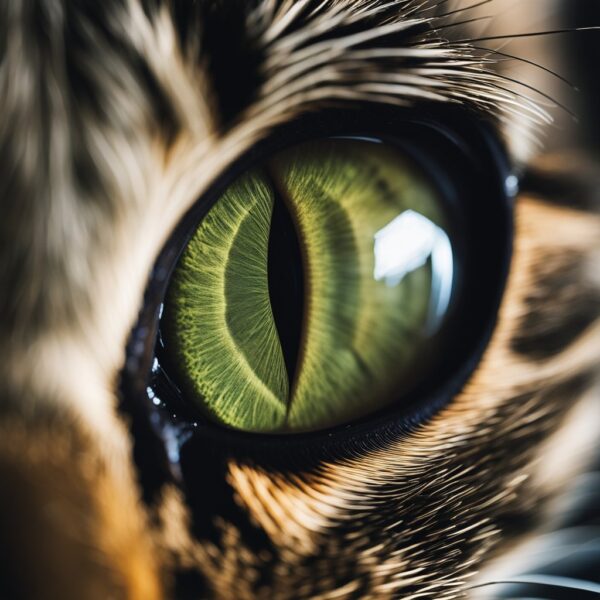
Cats Are Not Color Blind But are Dichromatic
Cats exhibit a fascinating sensory world remarkably different from that of humans, especially in terms of vision. Are cats color blind? This question has entertained cat parents and scientists alike, contemporary understanding of feline vision provides us with a clearer picture. Cats do indeed perceive colors, albeit in a more limited spectrum than humans. The notion of color blindness in cats is a topic of interest due to the differences in how they perceive their environment compared to our own vivid color experience.
Unlike humans who have trichromatic vision allowing them to see a wide array of colors, cats’ vision is dichromatic. This means they likely see colors on a blue and yellow scale, but lack the perception of the full range of hues that humans enjoy. Scientific studies have contributed to this understanding by examining the structure and function of cats’ eyes. They reveal that cats’ eyes have fewer cone receptors, which are responsible for color vision, and more rods, which are more sensitive to low light and motion. As such, while cats perform better in dimmer lighting conditions, their color perception is not as rich or varied as that of humans.
Key Takeaways
- Cats have a different color perception range compared to humans, seeing in a more limited spectrum.
- Feline vision is structured for low-light environments, favoring motion detection over color variety.
- The dichromatic nature of cat vision results in them potentially seeing colors like blue and yellow, but not the full range that human eyes can detect.

Fundamentals of Feline Vision
The vision of domestic cats is highly adapted for hunting. It features specialized eyes evolved for low-light environments and precise movement detection.
Evolution of Cat Eyes
Domestic cats’ ancestors were crepuscular predators, active during twilight, necessitating effective night vision. Over time, their eyes have evolved to maximize available light and detect even the subtlest of movements. This evolutionary path has resulted in a sensory tool tailored for their ecological niche as both predator and prey.
Anatomy of the Cat’s Eye
Cats’ eyes are built for optimal light absorption and motion detection:
- Pupil: Cats have slit-shaped pupils that can expand considerably, allowing them to see in low-light conditions.
- Retina: Comprising a high number of rod cells, it grants cats superior motion detection and night vision.
- Tapetum Lucidum: A reflective layer behind the retina that enhances light sensitivity, giving cats’ eyes a distinctive glow in the dark.
- Cone Photoreceptors: Fewer in number than humans, which suggests a less vibrant color perception akin to human red-green color blindness.

Common Myths about Cat Vision
Understanding feline vision involves dispelling misconceptions that have become popular beliefs.
Total Color Blindness Myth
The myth that cats experience total color blindness is inaccurate. They do, in fact, perceive colors, albeit not as vividly as humans do. Cats possess fewer cone photoreceptors in their retinas, meaning they detect a narrower range of colors. The perception of color by cats is comparable to humans who have red-green color blindness.
Night Vision and Color Perception
Another common misconception is that cats can see perfectly in complete darkness. While cats have an impressive ability to see in low-light conditions due to a high number of rod cells in the retina, they cannot see in absolute darkness. Their night vision is enhanced but not absolute, and this low-light sensitivity does not extend to their color perception, which is limited regardless of lighting conditions.

Color Perception in Cats
Cats possess a unique color vision that is quite different from humans, characterized by a dichromatic perception due to their distinct cone cell structure in the eyes.
Cone Cells and Color Vision
Cats’ retinas are equipped with two types of cone photoreceptors that specifically detect blue and green wavelengths. These cones are fewer in number compared to the cones found in human retinas. Consequently, cats’ color vision is limited compared to the trichromatic color vision of humans.
Comparing Cat Color Vision to Humans
Humans have three types of color receptors, each sensitive to red, green, or blue. Cats, on the other hand, lack the receptor for red wavelengths, thus rendering their world without this color. This limitation leads to a perception where certain colors, like reds and pinks, may appear as various shades of green, while purples can seem like another shade of blue.
- Human Vision:
- Can perceive a spectrum that includes red, green, and blue.
- Able to differentiate a wide range of hues.
- Cat Vision:
- Primarily perceives blue and green.
- Shades of yellow and gray may also be discernible.
- Reds and pinks are likely perceived as greens.
- Purples may appear as a different shade of blue.

Behavioral Evidence of Color Vision
Cats’ color vision has been a topic of considerable interest, leading to behavioral analyses that suggest they can perceive some colors.
Natural Predatory Behaviors
Cats are natural predators; their hunting strategies provide evidence for some degree of color vision. They often rely on subtle visual cues to track and pounce on their prey during dawn and dusk. At these times, the available light is limited, which would require cats to utilize all aspects of their vision, including color discrimination, to identify prey against various backgrounds.
Interactive Play and Color Discrimination
During interactive play, cats exhibit behavior that implies color discrimination capabilities. They may show preferences for certain colored toys over others, indicating that they can differentiate between colors. Some parents report their cats react more vigorously to toys of specific colors, such as blues and greens, compared to others. These anecdotal observations, while not conclusive, suggest that cats’ interaction with objects may be influenced by color perception.
Scientific Studies on Cat Vision
Recent scientific studies employing both physiological and behavioural methodologies have provided deeper insight into how cats perceive the world, revealing that feline vision differs significantly from human vision in terms of color perception.
Electroretinography Findings
Electroretinography (ERG), a diagnostic test that measures the electrical activity of the retina in response to light, has been instrumental in understanding cat vision. Studies utilizing ERG have shown that cats possess a higher number of rod cells relative to cone cells. Rod cells are highly sensitive to low light levels and do not discern color, which suggests that cats excel in dim lighting conditions but may have limited color vision. In terms of cone cells, which are responsible for color vision, research indicates that cats may possess dichromatic vision, with the cones mostly sensitive to wavelengths corresponding to blue and green hues.
Behavioural Response Experiments
Behavioural response experiments have provided additional insight into the color vision of cats. In these experiments, cats are typically presented with visual cues or tasks that require them to distinguish between different colors. Through this method, observations suggest that cats can differentiate between certain colors, particularly blues and greens. These findings counter the common assumption that cats are completely color blind, instead, painting a picture of a muted color spectrum, rather than a purely grayscale one. However, cats seem to have difficulty perceiving reds and may be less sensitive to this part of the spectrum.
ASre Cats Colorblind? Frequently Asked Questions
This section explores common inquiries regarding whether cats are color blind, providing succinct answers to deepen understanding of feline perception.
How do cats perceive color compared to humans?
Cats can see colors differently from humans due to a lower number of cone receptors in their retinas, resulting in less vibrant color perception, akin to some humans with color vision deficiencies.
What range of colors can cats see effectively?
Cats can see colors in the blue and yellow spectrum, but their ability to see reds and greens is limited, reflecting a range similar to humans with red-green color blindness.
Is there a difference in color perception between cats and dogs?
Cats may have a broader color perception range compared to dogs, as dogs are considered to have a vision similar to humans with red-green color blindness, although further research is needed to define these differences clearly.
How does a cat’s vision adapt to low light conditions?
Cats are adept at seeing in low light due to a high number of rod cells in their retinas and a reflective layer called the tapetum lucidum, which enhances light sensitivity.
Which colors are difficult for cats to distinguish?
Cats are not color blind but cats find it challenging to distinguish between colors at the red and green end of the spectrum, resulting in these colors appearing more muted or grayish.
In what ways is a cat’s color vision tested scientifically?
Scientific testing of a cat’s color vision is conducted through behavioral experiments that measure their ability to differentiate between colors, often using pattern-based or color-coded feeding trials. Cats are not color blind.